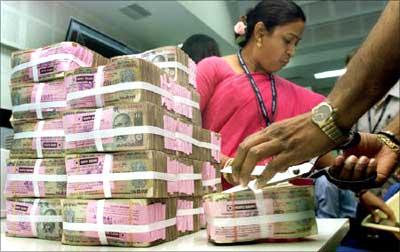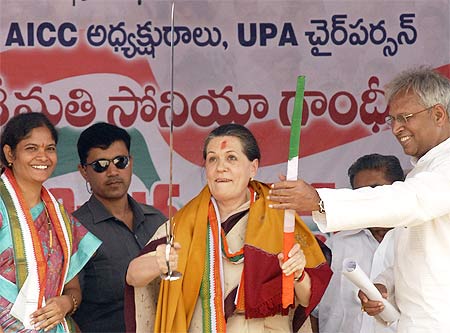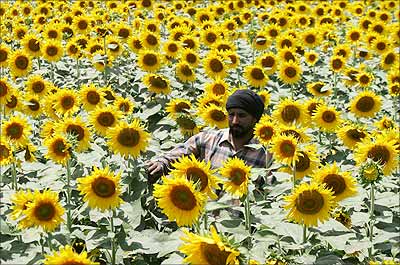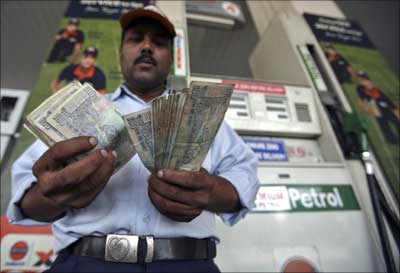Photographs: Danish Ismail/Reuters Vandana Gombar
It seems that notwithstanding the global financial crises, India is set to become a high-growth state and more of a welfare state under the new government.
The so-called work programme of 2009-2014 has already been chalked out in the Congress party manifesto and there should be no political or other constraints in pushing it through.
There is a good chance then that by 2014, the economy would be comfortably chugging along towards a double digit GDP growth rate or may even have reached it. At the same time, the footprint of the state would be much larger in the welfare space.
Here are the key elements of that journey to 2014:
The key to India's economic boom
Image: A cheerful boy waves Indian flagsPhotographs: Ashikur Rahman/Reuters
While there may or may not be another stimulus package, the move to a "moderate" goods and services tax (GST) in about ten months would provide a big boost to the economy.
As much as $15 billion of additional output could annually be added to India's trillion dollar economy as a result of the tax which would subsume all other central and state level indirect taxes and lead to the all-India common market.
The key to India's economic boom
Image: Indian currency notes in a bankThe plan to invest Rs 30,000 crore (Rs 300 billion) or a whopping $6 billion on a nation-wide skill development programme focused on the youth of the country should enhance national productivity, even if one assumes a low efficiency of the spend.
Similarly, the plan to connect each and every one of the 600,000 odd-villages of the country to a broadband network within three years would yield productivity gains even if one takes into account the fact that many of these villages continue to be denied the most basic facilities like electricity and water.
There is also the odd chance that broadband connectivity would expedite the provision of other basic support infrastructure.
The key to India's economic boom
Image: Sonia Gandhi holds a sword presented to her by a party member during an election campaign rally at Karimnagar north of HyderabadPhotographs: Krishnendu Halder/Reuters
Having sensed that its aam aadmi thrust has yielded results, there is going to be no holding back the Congress government on its welfare agenda. There is a plan for enactment of a Right to Food law. There is a commitment to provide 25 kilograms of rice or wheat monthly at Rs 3 a kilogram for families below the poverty line.
Subsidised community kitchens are proposed to be set up in all cities for the homeless people and migrants. And of course, the rural employment guarantee programme is to be strengthened.
There is also a plan to extend rural health insurance to every family living below the poverty line in three years. Social security cover for urban homeless, elderly and backward communities is proposed. Educational loans or scholarships are to be extended to all students.
There is talk of more schools with better trained teachers. There are special incentives planned for survival of the girl child aimed at correcting the adverse sex ratio.
There are also plans to take forward the scheme of monetary incentives to female students on the completion of various levels of schooling. The spends on these initiatives are certain, even though the outcome may not be.
The key to India's economic boom
Image: A farmer walks through his sunflower crop in a farm at Dayalpura village in PunjabPhotographs: Ajay Verma/Reuters
Welfare agriculture
In the case of agriculture, what is proposed to be done to boost industralisation of agriculture is not so clear though the welfare aspects of the government's agricultural plan are clearly marked out.
All small and marginal farmers in the country will have access to soft loans. To check the moral hazard that arises from the massive loan waiver programme, there is a plan to extend interest relief to farmers who repay their loans on schedule.
Crop insurance, direct income support to farmers in ecologically vulnerable areas and procurement at the doorstep of farmers are some of the other measures that are proposed in this term.
The key to India's economic boom
Image: A worker at a gas station counts currency notesPhotographs: Amit Gupta/Reuters
Missing the SME beat
The one sector which would boost employment and growth together would be the small scale industry, which contributes 40 per cent to the national manufacturing output and accounts for about a third of the country's exports.
The small scale units are among the worst hit by the financial crunch though they are yet to get a serious relief package.
The Congress party has however promised a "new deal" for the small units, as well as first generation entrepreneurs, which would include access to collateral-free credit and freedom from multiplicity of laws and inspectors.
There is also a plan for a cluster-based approach to growth of SMEs though one needs to see how quickly it would be put in place.
The key to India's economic boom
Image: Labourers work on a billboard in MumbaiPhotographs: Arko Datta/Reuters
The new government needs to work out a focused plan for the infrastructure sector if it is to meet its overall objective of high growth.
It is not immediately clear how much of the targeted $500 billion investment planned in the current five year plan has been managed in the two years that have passed, though one can be sure that it is inadequate.
Investment in infrastructure needs to be enhanced and tracked, even though it is not part of the work programme. The only thing mentioned there is the aggressive target of adding 12,000-15,000 Mw of power generation capacity every year without any explanation of how it will be done.
What is nevertheless welcome though is the stated intent of creating a new model of urban administration with financially-viable self-government institutions.
Land @ market rates: Market rates for agricultural land required for industrial projects and an option for the farmers to become stakeholders in the industrial ventures on their land, which is part of the work programme, would finally set to rest the controversies on land acquisitions.








article